Cereal and toast. Bagel and cream cheese. Bacon, eggs, and hash browns. If your go-to breakfast is getting tiresome — or you sense it’s not the healthiest choice — it’s probably time to reimagine what that first meal of the day could look like. To inspire you, we took a virtual trip around the world in search of healthful alternatives to many standard breakfasts.
We discovered different flavors — some savory, some bold and pungent, some mellow and naturally sweet. We found dishes you might consider dinner fare, such as warm soups and flavorful veggies. And we embraced new textures, including delicate cured fish and silky soft tofu. But we stuck with our principles for healthy eating.
“Most Americans build their breakfasts around carbohydrates,” says Julie Brown, MS, RD, nutrition coaching program director at Life Time. “Instead, we need to be building our breakfasts around proteins, leveraging carbohydrates as a side dish with the amounts varying based upon activity levels and personal health goals.”
Whether you’re curious about a new-to-you food or eager to totally change things up, these globally inspired breakfasts are your passport to flavor and good health.
1. Scandinavia
Featuring healthy fats, quality proteins, and complex carbs, the Nordic diet is a cool-temp version of the lauded Mediterranean diet. Try a smørrebrød, an open-faced sandwich on sourdough rye, slathered with grassfed butter and piled with smoked fish. Other sandwich toppers include pickled veggies, hard-boiled eggs, cheese, and charcuterie.
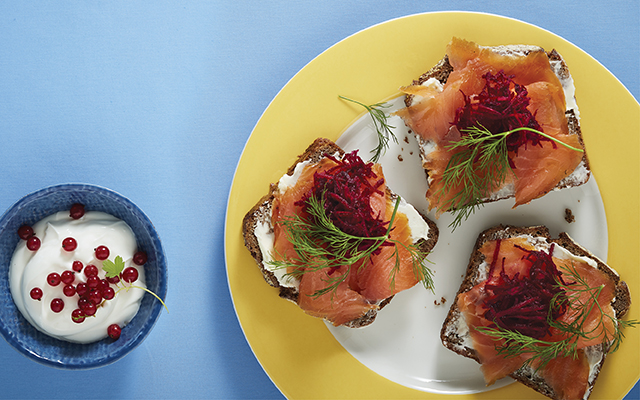 Photos: Terry Brennan; Food Styling: Lara Miklasevics
Photos: Terry Brennan; Food Styling: Lara Miklasevics- Sourdough rye bread is rich in prebiotic fiber that offers prolonged satiety. Look for loaves from local bakers who use a bacteria-rich starter (rather than fast-acting yeasts) to stimulate fermentation, which can make the gluten easier to digest.
- Fatty cold-water fish, such as gravlax (cured salmon), smoked mackerel, or pickled herring, deliver satiating protein, skin- and bone-boosting vitamin D, and anti-inflammatory omega-3 fats that support optimal triglycerides and blood pressure for heart health.
- Micronutrient-rich root vegetables are an important part of traditional Nordic diets. Grated raw or pickled beets add natural sweetness to a savory smørrebrød.
- Skyr, a creamy Icelandic dairy product with origins that go back a thousand years, has recently found its way to U.S. markets. It’s technically a cheese, but its thick consistency is comparable to Greek yogurt — and it’s similarly dense in protein and probiotics, which bolster digestive and immune health. Skyr production removes much of the lactose, so it can be easier to digest than other dairy options. Enjoy unsweetened skyr topped with berries or a sprinkle of muesli.
- Red currants and cloudberries are popular in Nordic countries, but you can also opt for vitamin-C-packed fresh or frozen raspberries or blueberries — including wild blueberries. “The advantage of using frozen is that the berries are picked at the peak of ripeness and flash-frozen, which locks in their flavor and nutrients,” says Frances Largeman-Roth, RDN, author of Eating in Color.
2. Middle East
Shakshuka — a traditional North African breakfast — features poached eggs in a bold tomato sauce. It serves up plenty of opportunities to improvise with other veggies, meats, and cheeses. Try it on its own or paired with protein- and fiber-packed freekeh — a smoked green, or unripe, wheat. (Check out our shakshuka recipe below.)
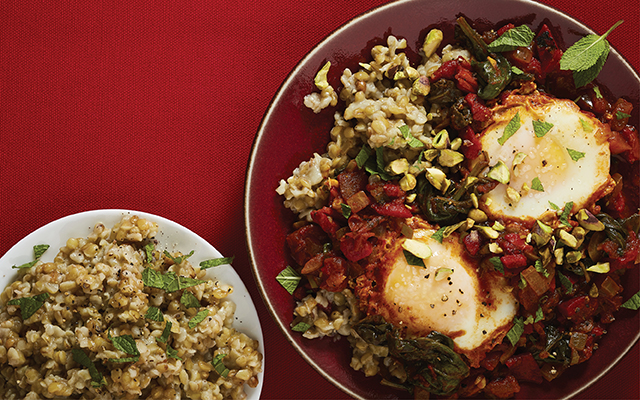 Photos: Terry Brennan; Food Styling: Lara Miklasevics
Photos: Terry Brennan; Food Styling: Lara Miklasevics- Pastured eggs provide naturally high levels of omega-3 fats, as well as vitamin D and enough high-quality protein to keep you satisfied through the morning.
- For the tomato sauce, start with canned tomatoes (in BPA-free cans). You’ll not only save time, but you may also get extra cancer-protective lycopene; some research has shown that cooking tomatoes increases the bioavailability of this nutrient.
- Shakshuka recipes vary by culture and region. Make this dish your own by adding your favorite nutrient-rich fresh veggies. Spinach, roasted red peppers, and mushrooms all add fiber and phytonutrients to your morning meal.
- Flavorful spices make shakshuka shine. Antioxidant-dense paprika brings heat as well as heart-healthy vitamin B6. Cumin has a warm, earthy flavor and is known for its digestion-supporting qualities. Turmeric adds anti-inflammatory curcumin to the mix as well as an aromatic, slightly pungent flavor.
- For some crunch and sustaining fats, sprinkle pistachios, almonds, or other nuts over your shakshuka. Top with chopped fresh herbs, such as mint and parsley, for a bright, flavorful boost of vitamins A and C.
- Made from roasted green durum wheat, smoky-flavored freekeh is not gluten-free, but it is high in protein and fiber, as well as iron, calcium, and zinc. It cooks up like quinoa or rice in a saucepan on the stove or in a rice cooker, and it’s a tasty whole-grain alternative to pita bread.
3. Japan
A traditional Japanese breakfast is light on the palate but heavy on nutrition. While you may think of soup and grilled fish as more appropriate for lunch or dinner, they’re a great way to get phytonutrient-rich vegetables and muscle-building protein into a meal that, in the United States, can be too often loaded with sugar and refined carbs.
 Photos: Terry Brennan; Food Styling: Lara Miklasevics
Photos: Terry Brennan; Food Styling: Lara Miklasevics- Made from fermented soybeans, miso paste transforms a steaming pot of water into a delicate, umami-flavored broth — and offers a dose of digestion-supporting probiotics. To preserve its living microorganisms, avoid boiling the broth.
- Sea vegetables, such as wakame and nori, infuse miso with iron, zinc, and calcium, as well as iodine, which helps optimize thyroid function.
- A pinch of minced fresh gingerroot adds anti-inflammatory compounds and a pop of flavor, while a topping of sliced scallions brings freshness and a hit of the antioxidant quercetin.
- For protein and essential micronutrients, add cubes of soft tofu to the soup. You can also enjoy a side of grilled fish, such as wild salmon or mackerel, slices of egg omelet, or shelled edamame.
- Skip the white rice and try nutty-tasting Japanese soba noodles. Look for soba made from 100 percent buckwheat, a gluten-free seed that’s a source of magnesium, copper, and niacin.
- Round out your breakfast with a comforting cup of green tea. Shade-grown varieties, such as matcha, are especially rich in calming theanine, while sun-grown teas, such as sencha, feature antioxidant compounds called catechins that protect cardiovascular health.
4. Mediterranean
The traditional foods of this temperate region inspire a light, fresh, mix-and-match breakfast packed with sweet and savory flavors that will keep you going without weighing you down.
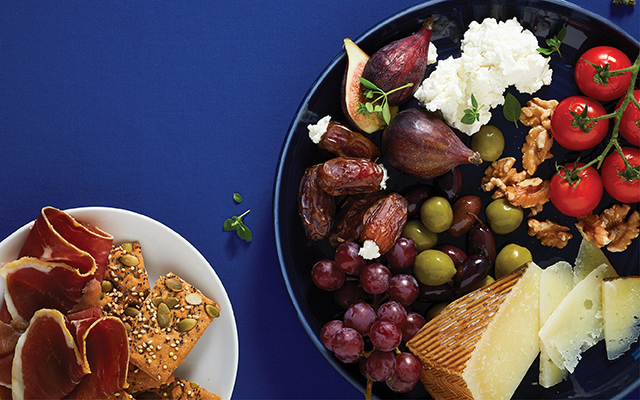 Photos: Terry Brennan; Food Styling: Lara Miklasevics
Photos: Terry Brennan; Food Styling: Lara Miklasevics- Indulge in a small serving of goat’s- or sheep’s-milk cheese. These cheeses can be easier to digest than those made from cow’s milk because they lack A1 beta casein, which causes problems for many. Try tangy French chèvre, salty Italian pecorino (naturally high in conjugated linoleic acid, or CLA), firm and buttery Spanish manchego, or probiotic-rich Greek feta. For a touch of sweetness, drizzle with local raw honey.
- Fresh fruits, such as figs, offer fiber, potassium, vitamin K, and manganese. Grapes, pomegranate seeds, and citrus fruits are vitamin-C-rich options that naturally sweeten your spread. For an added twist (and extra fiber), stuff Moroccan Medjool dates with soft cheese or serve them with Greek yogurt.
- Nosh on several briny Sicilian Castelvetrano or Greek kalamata olives. These fermented fruits offer antioxidant phenolic compounds and also deliver gut-friendly bacteria.
- Fresh veggies help you pack in more phytonutrients at the start of your day. Nibble a few slices of roasted red pepper livened up with thyme, oregano, or other fresh herbs. Balance the sweetness of cherry tomatoes — technically a fruit, though considered a veggie for their flavor profile — with a drizzle of extra-virgin olive oil.
- For added crunch, go for nuts. Scatter shelled walnuts on your plate for a nutritional windfall — including omega-3 fatty acids. “New research has found that walnuts help boost gut and brain health,” notes Largeman-Roth. Hazelnuts, pistachios, and almonds can also keep you feeling satiated with the dynamic duo of plant protein and healthy fats.
- Include a few slices of a high-quality cured meat, such as Italian prosciutto, soppressata, Spanish chorizo, or jamón Serrano, for a protein bump that will help stabilize blood-sugar levels.
- Seed-based crackers are a great way to get grains. Look for gluten-free options — or even make your own. (For a recipe, see “Endurance Crackers.”)
5. Latin America
Traditional breakfasts vary among the countries and regions of Central and South America, but many people focus on satiating whole foods and eschew sugary processed items.
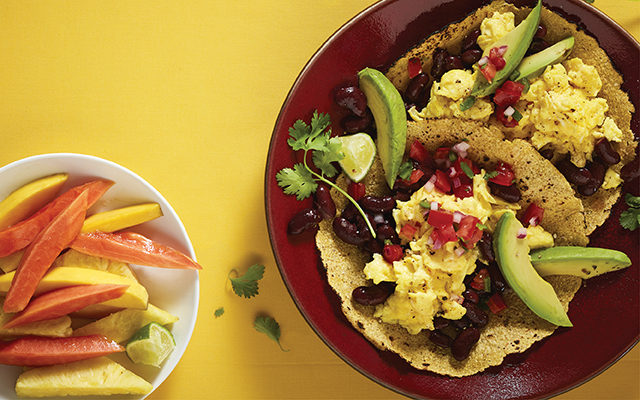 Photos: Terry Brennan; Food Styling: Lara Miklasevics
Photos: Terry Brennan; Food Styling: Lara Miklasevics- Authentic corn tortillas made from masa harina — flour made from dried corn treated with limewater — are a gluten-free alternative to flour tortillas. They’re also a source of lutein, a phytochemical linked to better eye health.
- Throughout Latin America, the beans from last night’s dinner often become the centerpiece of this morning’s breakfast. Their protein and fiber can help stabilize blood sugar and leave you feeling satiated longer. “Beans are also good sources of B vitamins and minerals that provide energy throughout the day,” says integrative nutritionist Michelle Babb, MS, RD, CD.
- Try a scramble of local, pastured eggs — a source of choline for better memory and cognition — as a main ingredient of your tacos.
- Creamy avocado is a nutritional heavyweight, serving up monounsaturated fat, fiber, potassium, folate, and vitamin K. Whip up some guacamole or top tacos with sliced avocado. Or cut an avocado in half, remove the pit, and mash up the flesh, then tuck your favorite taco fillings into each half.
- For a punch of flavor and texture, add fiery salsa; you’ll also get the hunger-fighting, metabolism-revving benefits of chili peppers. Make a quick one by tossing together chopped tomatoes, red onion, jalapeño, cilantro, and a squirt of lime juice.
- Add a side of fresh tropical fruit to your breakfast: Pineapple, mango, papaya, and ripe plantain all provide immune-boosting vitamin C and other antioxidants.
Shakshuka
Makes four to six servings
Prep time: 15 minutes
Cook time: 25 to 30 minutes
Ingredients
- 2 tbs. extra-virgin olive oil
- 1 medium yellow onion, diced
- 2 cloves garlic, minced
- 1 large jalapeño, seeded and minced
- 1 tbs. paprika
- 2 tsp. ground cumin
- 1/2 tsp. turmeric
- 1 large jarred roasted red bell pepper, drained and patted dry, coarsely chopped
- 15 oz. canned fire-roasted diced tomatoes
- 1/2 tsp. salt
- 1/2 tsp. freshly ground black pepper
- 2 cups baby spinach, roughly chopped
- 4 to 6 large eggs
- 1/4 cup chopped fresh mint
- 1/4 cup toasted pistachios, chopped
Directions
- In a 12- to14-inch skillet, warm the olive oil over medium-high heat for several seconds, then add the onion. Stir until the onions start to sizzle, then reduce the heat to medium-low; cook, stirring occasionally, for about five minutes. Add the garlic and jalapeño and stir for another minute, then add the paprika, cumin, and turmeric. Cook, stirring occasionally, until fragrant (about two minutes).
- Add the pepper and diced tomatoes and increase the heat to medium high; bring the mixture to a boil. Add salt and pepper and stir, then reduce the heat to medium. Simmer until the mixture is slightly thickened, about eight minutes. Stir in the spinach and cook for one minute, just to wilt.
- Using a large soup spoon, make a well about an inch from the edge of the pan; crack an egg, and slide the egg into the well. Quickly repeat the process with the other eggs, spacing them evenly around the perimeter of the pan. Sprinkle a pinch of salt over the eggs.
- Reduce the heat to low and cook for about eight minutes. Once the egg whites start to firm up, use your spoon to drizzle a bit of the sauce over just the whites. Cook until the whites are set and the yolks have the desired degree of runniness.
- Sprinkle the shakshuka with mint and pistachios and serve.
Note: For a protein boost, slice a 4-ounce link of precooked Moroccan merguez or even andouille sausage into the pan with the onions, and proceed. Feta would be a nice option for a garnish; add before topping with mint and pistachios.
This originally appeared as “Around the World in 5 Breakfasts” in the November 2018 print issue of Experience Life.
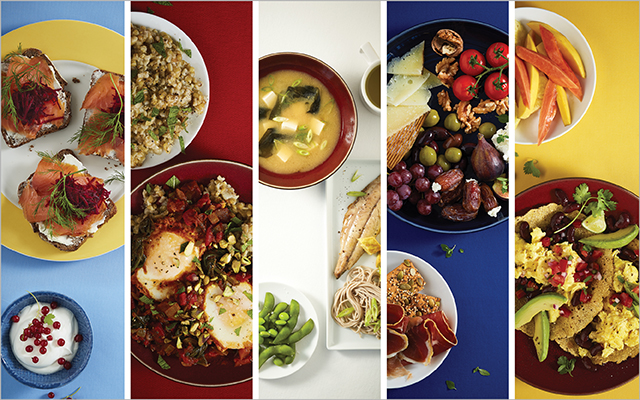


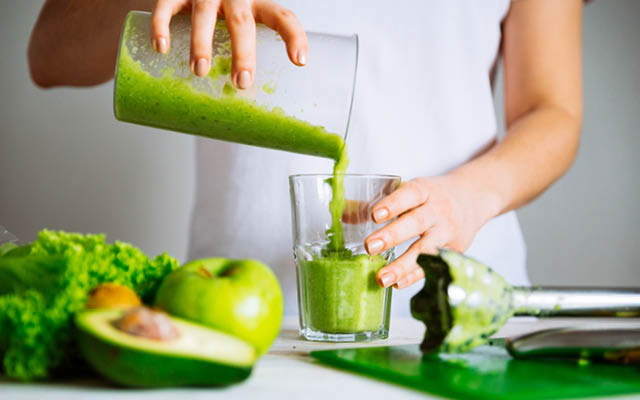
This Post Has 0 Comments